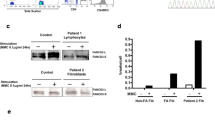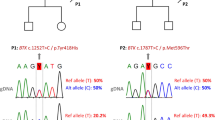Abstract
Common variable immunodeficiency (CVID) is a highly heterogeneous disease with an unpredictable pattern. CVID appears to have an immunologic and clinical phenotype similar to some hereditary humoral immunodeficiencies, including X-linked lymphoproliferative disease (XLP).The differential diagnosis of CVID and XLP is clinically of importance, because the two diseases have markedly different prognoses and treatment. The recent identification of the XLP gene, known asSH2D1A, has permitted a definitive diagnosis of XLP. In this report, we describe a male patient with XLP who initially received a diagnosis of CVID and developed a fatal course. Using genetic analysis, we confirmed that the patient harbored theSH2D1A gene mutation.The results support the notion that the possibility of aSH2D1A gene mutation should be considered in hypogammaglobulinemic male patients before a diagnosis of CVID is made. Int J Hematol.
Similar content being viewed by others
References
Cunningham-Rundles C, Bodian C. Common variable immunodeficiency: clinical and immunological features of 248 patients.Clin Immunol. 1999;92:34–48.
Cunningham-Rundles C. Hematologic complications of primary immune deficiencies.Blood Rev. 2002;16:61–64.
Spickett GP, Webster AD, Farrant J. Cellular abnormalities in common variable immunodeficiency.Immunodefic Rev. 1990;2:199–219.
Stagg AJ, Funauchi M, Knight SC, Webster AD, Farrant J. Failure in antigen responses by T cells from patients with common variable immunodeficiency (CVID).Clin Exp Immunol. 1994;96:48–53.
Fischer MB, Hauber I, Eggenbauer H, et al. A defect in the early phase of T-cell receptor-mediated T-cell activation in patients with common variable immunodeficiency.Blood. 1994;84:4234–4241.
Di Renzo M, Zhou Z, George I, Becker K, Cunningham-Rundles C. Enhanced apoptosis of T cells in common variable immunodeficiency (CVID): role of defective CD28 co-stimulation.Clin Exp Immunol. 2000;120:503–511.
Di Renzo M, Serrano D, Zhou Z, George I, Becker K, Cunningham-Rundles C. Enhanced T cell apoptosis in common variable immunodeficiency: negative role of the fas/fas ligand system and of the Bcl-2 family proteins and possible role of TNF-RS.Clin Exp Immunol. 2001;125:117–122.
Kanegane H, Tsukada S, Iwata T, et al. Detection of Bruton’s tyrosine kinase mutations in hypogammaglobulinaemic males registered as common variable immunodeficiency (CVID) in the Japanese Immunodeficiency Registry.Clin Exp Immunol. 2000;120:512–517.
Farrington M, Grosmair LS, Nonomyamas S, et al. CD40 ligand expression is defective in a subset of patient with common variable immunodeficiency.Proc Natl Acad Sci U S A. 1994;91:1099–1103.
Ferrai S, Giliani S, Insalaco A, et al. Mutation of CD40 gene cause a novel autosomal recessive form of hyper IgM.Proc Natl Acad Sci U S A. 2001;98:12614–12619.
Revy P, Muto T, Levy Y, et al. Activation-induced cytidine deaminase (AID) deficiency causes the autosomal recessive form of the hyper-IgM syndrome (HIGM2).Cell. 2000;102:565–575.
Morra M, Silander O, Calpe S, et al. Alterations of the X-linked lymphoproliferative disease gene SH2D1A in common variable immunodeficiency syndrome.Blood. 2001;98:1321–1325.
Nistala K, Gilmour KC, Cranston T, et al. X-linked lymphoproliferative disease: three atypical cases.Clin Exp Immunol. 2001;126: 126–130.
Purtilo DT, Cassel CK,Yang JP, Harper R. X-linked recessive progressive combined variable immunodeficiency (Duncan’s disease).Lancet. 1975;1:935–940.
Hamilton JK, Paquin LA, Sullivan JL, et al. X-linked lymphoproliferative syndrome registry report.J Pediatr. 1980;96:669–673.
Seemayer TA, Gross TG, Egeler RM, et al. X-linked lymphoproliferative disease: twenty-five years after the discovery.Pediatr Res. 1995;38:471–478.
Nichols KE, Hakin DP, Levitz S, et al. Inactivating mutations in an SH2 domain-encoding gene in X-linked lymphoproliferative syndrome.Proc Natl Acad Sci U S A. 1998;95:13765–13770.
Sayos J, Wu C, Morra M, et al. The X-linked lymphoproliferativedisease gene product SAP regulates signals induced through the co-receptor SLAM.Nature. 1998;395:462–469.
Coffey AJ, Brooksbank RA, Brandau O, et al. Host response to EBV infection in X-linked lymphoproliferative disease results from mutations in an SH2-domain encoding gene.Nat Genet. 1998;20:129–135.
Yin L, Ferrand V, Lavoue MF, et al. SH2D1A mutation analysis for diagnosis of XLP in typical and atypical patients.Hum Genet. 1999; 105:501–505.
Sumegi J, Huang D, Lanyi A, et al. Correlation of mutations of the SH2D1A gene and Epstein-Barr virus infection with clinical phenotype and outcome in X-linked lymphoproliferative disease.Blood. 2000;96:3118–3125.
Grieson HL, Sakre J, Church J, et al. Evaluation of families where a single male manifests a phenotype of X-linked lymphoproliferative disease (XLP).Am J Med Genet. 1993;47:458–463.
Bar RS, DeLor CJ, Clausen KP, Hurtubise P, Henle W, Hewetson JF. Fatal infectious mononucleosis in a family.New Engl J Med. 1975; 290:363–367.
Howie D, Sayos J, Tehorst C, Morra M. The gene defective in X-linked lymphoproliferative disease controls T cell dependent immunosurveillance against Epstein-Barr virus.Curr Opin Immunol. 2000;12:474–478.
Pracher E, Panzer-Grumayer ER, Zoubek A, Peters C, Gadner H. Successful bone marrow transplantation in a boy with X-linked lymphoproliferative syndrome and acute severe infectious mononucleosis.Bone Marrow Transplant. 1994;13:655–658.
Hoffman T, Heilman C, Madsen HO, Vindelov L, Schmiegelow K. Matched unrelated allogeneic bone marrow transplantation for recurrent malignant lymphoma in a patient with X-linked lymphoproliferative disease (XLP).Bone Marrow Transplant. 1998;22:603–604.
Author information
Authors and Affiliations
Corresponding author
About this article
Cite this article
Aghamohammadi, A., Kanegane, H., Moein, M. et al. Identification of anSH2D1A mutation in a hypogammaglobulinemic male patient with a diagnosis of common variable immunodeficiency. Int J Hematol 78, 45–47 (2003). https://doi.org/10.1007/BF02983239
Received:
Revised:
Accepted:
Issue Date:
DOI: https://doi.org/10.1007/BF02983239




